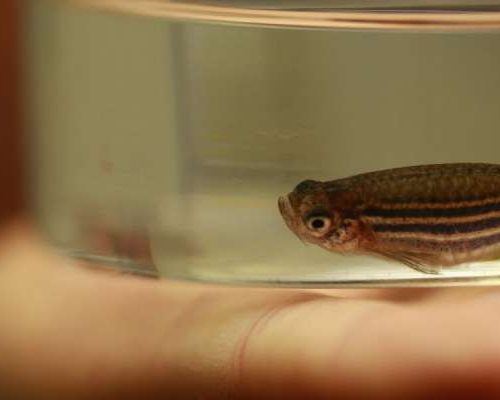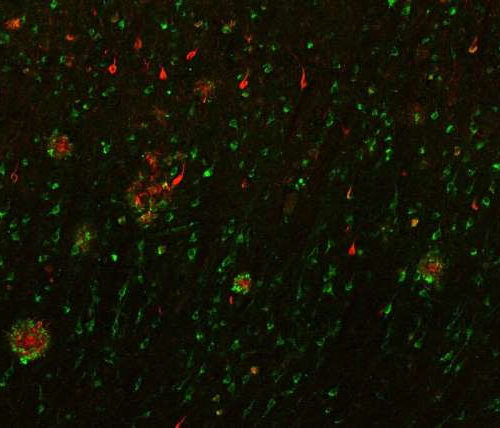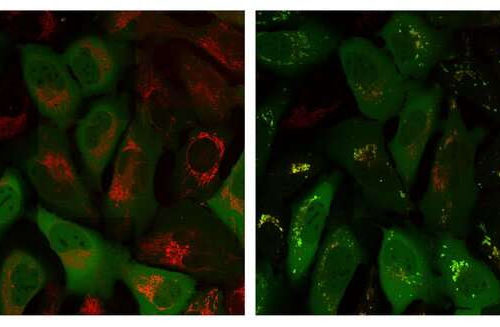by Victor Chang Cardiac Research Institute A zebrafish. Credit: Victo Chang Cardiac Research Institute Scientists at the Victor Chang Cardiac Research Institute in Sydney have discovered a critical new gene that it is hoped could help human hearts repair damaged heart muscle after a heart attack. Researchers have identified a genetic switch in zebrafish that turns on cells allowing them to divide...
PLD3 gene contributes to risk of Alzheimer’s disease
by Public Library of Science This image shows the close relationship between phospholipase D3 and the pathological hallmarks of Alzheimer’s disease in tissue from the temporal lobe of a human brain. Phospholipase D3, which is primarily in neurons, is shown in green and neuritic plaques and neurofibrillary tangles are in red stained with thiazine red. Credit:...
A new agent for the brain diseases: mRNA
TOKYO MEDICAL AND DENTAL UNIVERSITY IMAGE: Brain-derived neurotrophic factor (BDNF) serves as a potential candidate neuroprotective agent, but there are almost no successful clinical trials due to high hurdle in brain access and short half-life. Fukushima et al. show intraventriclarly administered BDNF mRNA using polyplex nanomicelle exerted a prominent effect to prevent neuronal death with...
Moffitt investigators identify STING gene methylation allows melanoma to evade the immune system
H. LEE MOFFITT CANCER CENTER & RESEARCH INSTITUTE TAMPA, Fla. (April 8, 2021) — A dysfunctional immune system significantly contributes to the development of cancer. Several therapeutic strategies to activate the immune system to target cancer cells have been approved to treat different types of cancer, including melanoma. However, some patients do not show beneficial clinical responses...
A drug that can stop tumors from growing
UNIVERSITY OF COLORADO ANSCHUTZ MEDICAL CAMPUS Cancer doctors may soon have a new tool for treating melanoma and other types of cancer, thanks to work being done by researchers at the University of Colorado Cancer Center. In a paper published in the journal PNAS last month, CU Cancer Center members Mayumi Fujita, MD, PhD, Angelo D’Alessandro, PhD, Morkos Henen,...
Society is not ready to make human brains
KYOTO UNIVERSITY Stem cell research has allowed medicine to go places that were once science fiction. Using stem cells, scientists have manufactured heart cells, brain cells and other cell types that they are now transplanting into patients as a form of cell therapy. Eventually, the field anticipates the same will be possible with organs. A new paper...
Bacterial “homing missiles” could unlock new antibiotic treatments
By Michael Irving April 07, 2021 An artist’s model of a tailocin, puncturing a bacterial membraneZhou Lab; Dan Weisman/UCLAVIEW 1 IMAGES Microscopic wars are constantly raging all around, on and inside us, as bacteria fight for resources and room. They’ve developed some crafty weapons in the process, such as tailocins, which act somewhat like “homing...
Scientists identify new differences between the sexes in age-related changes to brain stem cells
INTERNATIONAL SOCIETY FOR STEM CELL RESEARCH IMAGE: MULTIPLEX IMAGING OF A MOUSE 3D ADULT NEURAL STEM CELL NICHE STAINED TO REVEAL BLOOD VESSELS (RED), GLIA AND PROGENITOR CELLS (GREEN) AND YOUNG NEURONS (TURQUOISE). COMPUTER BASED ANALYSIS OF THESE IMAGES FROM MALES AND FEMALES HAS REVEALED SEX-DIFFERENCES IN AGING OF THE STEM CELL NICHE. CREDIT: IMAGE CREDIT:...
Chronic sinus inflammation appears to alter brain activity
UNIVERSITY OF WASHINGTON SCHOOL OF MEDICINE/UW MEDICINE The millions of people who have chronic sinusitis deal not only with stuffy noses and headaches, they also commonly struggle to focus, and experience depression and other symptoms that implicate the brain’s involvement in their illness. New research links sinus inflammation with alterations in brain activity, specifically with the neural...
Parkinson’s, cancer, type 2 diabetes share a key element that drives disease
by Salk Institute Parkin protein (green signal) is in a different part of the cell than the mitochondria (red signal) at time 0 (left image) but then co-localizes with the mitochondria after 60 minutes (right image). Credit: Salk Institute When cells are stressed, chemical alarms go off, setting in motion a flurry of activity that protects...






